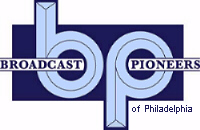

TV Studio
WFIL-TV
1948
![]()
This studio is 55 feet long, 25 feet 6 inches wide and 23 feet high. It was designed to allow one scene to be set up at one end of the studio and another at the opposite end; with cameras in the center and the control operators having a good view of both sets. In practice, a third shallow set may be placed along the side wall facing the control room, although this begins to crowd things a bit and considerably restricts the camera operating area.
The floor of the WFIL-TV studio is composed of tile blocks laid on concrete. The walls and ceiling are covered with perforated transite. This provides an acoustical condition which would be on the "dead" side by AM standards. This is the present practice in TV studio design. The operation of camera dollies and microphone booms, the occasional moving of scenery, and the presence of many people in the studio, results in background noise which would be noticeable and objectable if the studio were "live." When desirable, the "flats" used as scenery may be utilized to provide extra liveness for particular scenes.
Many minor operational features are provided in the studio. One is a wiring duct which runs around the studio about one foot from the floor. This contains outlets every few feet which provide 110 volts or 220 volts, AC or DC for lighting and other needs. In one corner is (a) floor opening containing gas and water inlets (for cooling demonstrations, etc.) A wood framework on the walls around all four sides provides a means of bracing scenery.
The caption for the photo says:
A view of one end of the WFIL-TV studio as set up for telecasting of a show ("Phil and the Three Cheers"), which requires a drug store soda fountain scene. Equipment in this studio includes an MI-2657A Perambulator Boom on which is mounted a Type 77-B Microphone. (Note cable dropping down from opening in ceiling, a Type KS-4A Stand (far left) on which is mounted a Type 88-A Microphone, one Type TK-30A Studio Camera on a crane-type dolly, and another TK-30A Studio Camera, which is temporarily mounted on a field tripod with dolly attachment.)
Broadcast Pioneers members Allen Murphy and Shelly Gross (Shelly worked out of this studio during his days at WFIL) believe that the article is correct and that this is the 46th and Market Street studio. Broadcast Pioneers member Gerry Wilkinson, who worked on the last live program to originate from Studio B at 46th and Market when it belonged to WHYY-TV says that it does look somewhat like the 46th Street studio, but then added that he never saw the Widener studios. At the time that Wilkinson worked at the 46th Street location, Studio A was used for storage and you couldn't get a real feel for what it looked like. FYI, Studio B was the studio used for AMERICAN BANDSTAND when it originated from WFIL-TV.
David D. Derozier, a visitor to our website (and a part-time video free-lancer) e-mailed:
This is a picture of "Studio 'A'" at the WFIL-TV Building (4548 Market Street). "Studio 'B'" did not exist until the building was added onto in 1952 (Triangle not only added "Studio 'B'", but they also consolidated their radio operations from the Widener Building into this facility). "Studio 'B'" also was the largest of the studios in the building (80'x42'x24') ...The early pioneers have a lot to teach the supposed "professionals" in television today.
Stephen Burkart, a visitor to our website e-mailed:
What is described in the text as a "MI-2657A Perambulator Boom on which is mounted a Type 77-B Microphone" is in fact the classic Mole Richardson Co. Type 103B Perambulator with the Type 126B Microphone Boom.
![]()
From the official archives of the Broadcast Pioneers of Philadelphia
Photo courtesy of Mike Femyer.
© 2006 & 2014, Broadcast Pioneers of Philadelphia
All Rights Reserved
The e-mail address of the Broadcast Pioneers of Philadelphia is pioneers@broadcastpioneers.com